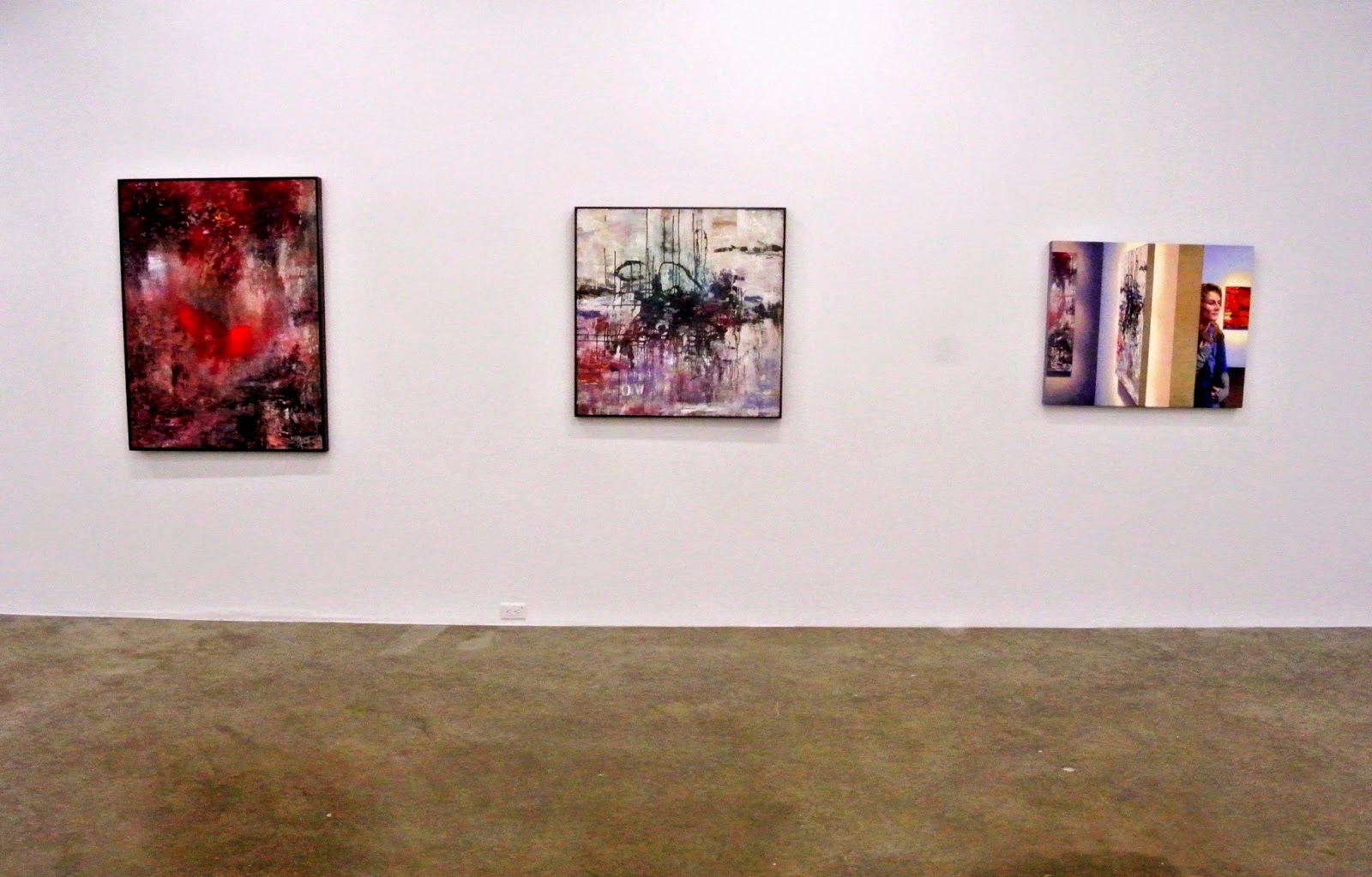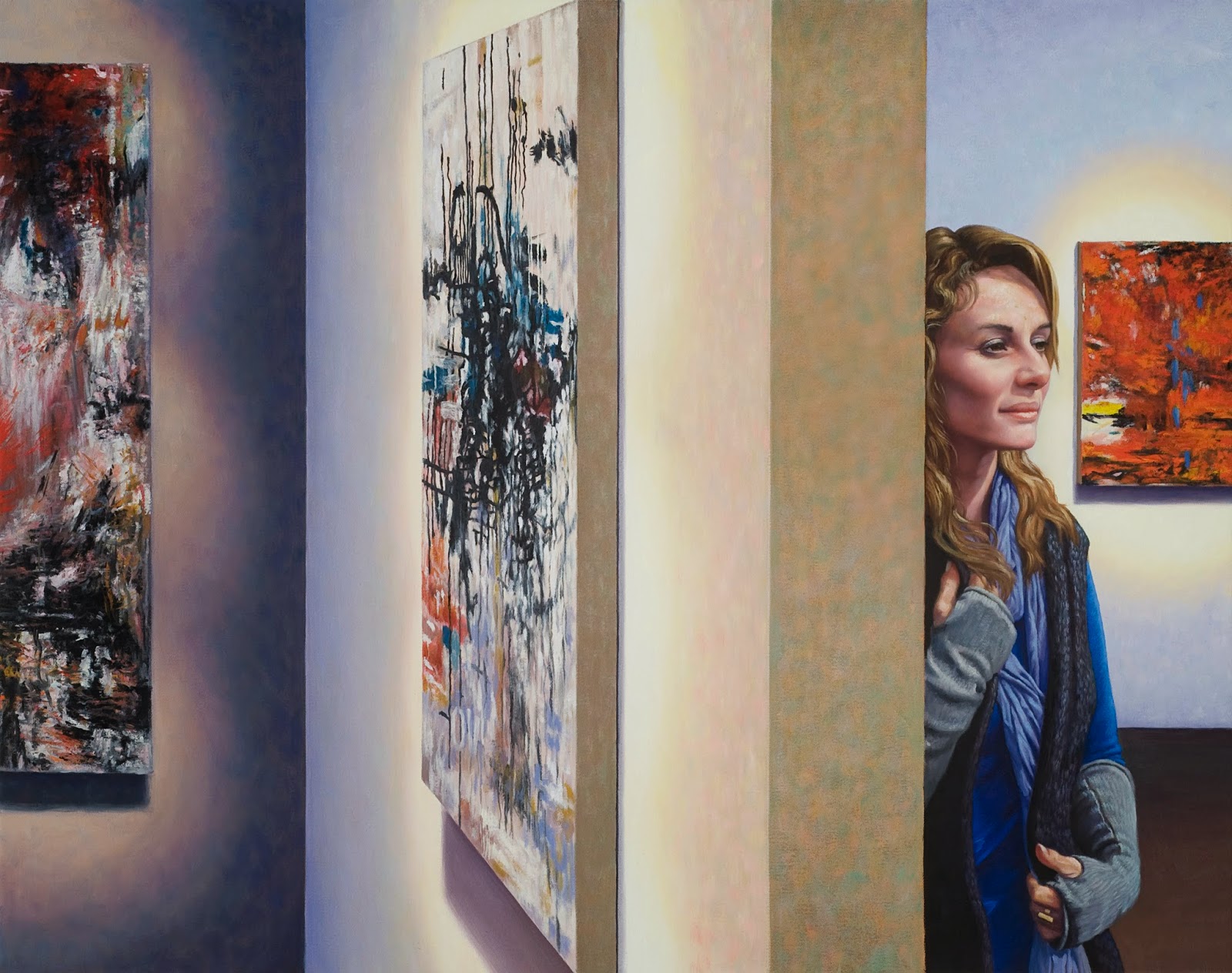CONCURRENT - MARK LANG & VERONA SORENSEN
Mark and Verona put forward a very collaborative approach to exhibiting their work in Concurrent. Their statements offer a comprehensive response to what they selected to show, and why. These works have proven very popular at the gallery. It feels as though this trio should be acquired altogether as they are of the same body and spirit.
Over the years
when Mark Lang and I would bump into each other, ‘time’ would seem to distort
itself. More often than not we would get fully immersed in conversations only
to realize an hour, if not more, had just whizzed by while we stood, say, on a
street corner, exchanging thoughts and perspectives. Sometimes in an instant –
if lucky – one can glimpse the ‘essence’ of a person, all details and
complexities aside. Similarly, when I paint an abstract image, I strive for the
essence of an emotion, an experience, a moment in time, and let the specifics
of the story lightly fade from the picture.
The dynamics between abstract
and figurative art have always fascinated me. When I first began to paint, I
focused solely on refining my ability to portray a realistic figure. For years
this was what I developed, then at a turning point I began to explore
abstraction and it seemed to envelop me completely. For myself, one approach
was more calming and orderly and the other more chaotic and instinctual. At the
end of the day, however, it is all painting. As Mark wrote, “an abstract
painting and a figurative one are essentially the same thing, pigments
organized in a certain way on a surface.” I 'read'
figurative painting like a narrative story and abstraction like a poem; both
can be relished and savoured and appreciated, one tends to be more specific
while the other is slightly elusive.
The
particularities of a painting can be so precious and rich that when one dives
into them the experience can
be one of awe. This often happens to me when viewing
the paintings of Mark Lang. The realistic details captured are of a refinement
and exactitude that is jaw-dropping and inspiring. When I was most recently in
Europe I recognized Mark’s paintings alive in the flesh before me, particularly
in Italian and British museums. I would watch a guard slowly stride across a
room, past onlookers immersed in works by Vermeer and Rubens, while a student
painter with easel, canvas, and brush in hand attempted to capture the nuances
of whatever masterpiece was before him, and it reminded me of the movement that
springs up around and in front of the paintings that hang in our lives. It was
like watching a Mark Lang scene just before it unravels itself into parallel
mirroring dimensions. I actually felt like I was walking through one of his
paintings.
Whenever I see Verona she
always seems to be just returning from a trip or just about to leave on another
one. We run into each other randomly at events, on the street, even once at a
funeral. On occasion we visit each other’s studios and talk painting a bit, but
I find our conversations always wander off into some other interesting territory. She has philosophical tendencies. We have known each
other for quite a few years now, and yet, because of the transitory nature of
the relationship, I would say we don’t know each other particularly well. We’ve
collaborated in the past on paintings where Verona has acted as model. To my
intuition, she seemed right for various images, and she has added a dimension
to them that would not have been there
without her presence. From looking at our work and the difference in our
approach, you might think we would not have much in common, but I think this
would be wrong. My own particular interest lies in images, their history and
mythology, visual perception and the relationships between the depiction of
reality and the experience of it. I try to explore these interests in a playful
manner, but through highly organized pictures in what people might commonly
think of as a “traditional” style. Verona explores her interests with a
different approach, more “modernist” and expressive in the use of the medium,
not image based, but not necessarily less organized. Some of our interests
overlap. In both cases, the form of a particular painting reflects the content
of each painter’s interest in doing it. She can explain her own interests much
better than I ever could, so I leave that to her.
For this project Verona and I
sat down briefly and discussed a few ideas. ( just before she went off on a
trip) After this meeting, I decided to do a portrait of her depicting her and
some of her work, that reflects the relationship I’ve just described. In
portraiture, there are three basic poses: the frontal view, the profile and the
three quarter view. Traditionally the three quarter view is regarded as the
most revealing, because it shows aspects of both the frontal view and the profile.
I thought it was interesting that linguistically, the term “three quarter view”
sounds more limited than “profile” and “frontal”. We think of frontal as
something direct and confrontational, and the word profile even refers to a
detailed list of someone’s attributes, as in “doing a profile on someone”.
These two terms imply completeness, but three quarters implies something
partially known. I decided to use this as a point of departure for the painting
because of my feeling that our interests overlap, but that we know each other
only partially. I incorporated the idea of the three quarter view in several
ways. First, I decided to make an indirect reference to geometric abstraction
in the background because Verona’s father was also an abstract painter who
often used geometry in his compositions. I divided the canvas geometrically
into vertical and horizontal bands, one quarter the size of the canvas each and
used those divisions as the foundation for the composition. They become the
background, or environment of the picture, constituting a gallery space. Next,
with Verona’s permission I included partial facsimiles of three of her
paintings. My copies are nowhere near as rich as the real thing, but just
enough to give an impression of how they look from a distance. There is
something absurd about trying to reproduce such expressive paintings in such a
controlled way. I placed one of them in perspective in a three quarter view.
This bit of visual humour refers to the contrast between the flat surface of a painting
in opposition to the illusion of three dimensions. This draws attention to the
idea that an abstract painting and a figurative one are essentially the same
thing, pigments organized in a certain way on a surface. Finally, I’ve painted
a representation of Verona herself in three quarter view, partially obscured,
exactly three quarters of the way across the composition. From the waist up,
only three quarters of her is visible and she extends three quarters of the way
up the canvas. The image is based on photos she sent me from her travels in
Italy. It only partially resembles her. I hope it shows distance, but a certain
respect and fondness. This gives the impression of someone seen only partially,
in passing, appreciated, but who isn’t fully known.




Comments
Post a Comment